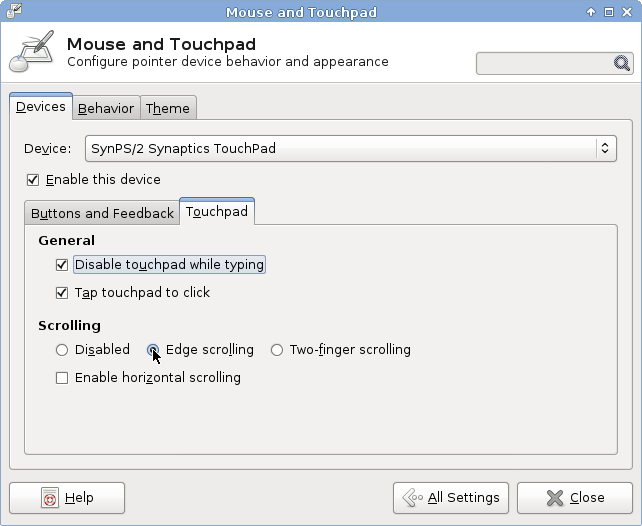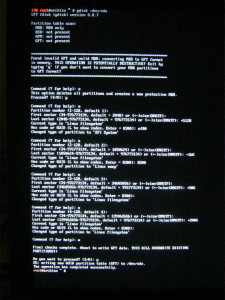My server Pi, well… it still needs some server stuff to be installed. Installing git has been forever on my TODO list. One of the things that are supposed to be handles by this git server is nightly backups of my dedicated server, which hosts this blog among a number of other sites. Originally, my BeagleBoard was supposed to have this role, but due its instabilities, I have never set it us as a git server. At some point in time, Eileen wanted to set up a server at her place, and asked me to help her with configuring it. So I asked if I could have some space on that server for backup purposes. Unfortunately, that machine was unstable as well, so it shut down as well.
To manage git, we’re going to use gitosis. The very same way as is done on my dedicated server (at ovh). But we’re going to use a different configuration. The ovh server exports all repositories, while here we’re going to set up private repositories. But we also want to have the possibility to have public repositories. We will also configure gitweb to have a nice interface to those public repositories.
This configuration is performed on a Raspberry Pi running ArchLinuxARM. However, this guide could be applied to regular ArchLinux on i386 or x86_64 as well.
Let’s get started, shall we?
[andre@rpi-server ~]$ yaourt -S gitosis-git
We have to create set the home directory for the git user manually:
[root@rpi-server home]# mkdir /srv/gitosis
[root@rpi-server home]# usermod -d /srv/gitosis/ git
Since we’re hosting this on a raspberry pi, and don’t want to store the repository on the SD Card, we’re going to apply the same method as we’re dong during the setup of the NFS shares: We add the following line to our fstab
/home/gitosis /srv/gitosis none bind 0 0
Which basically means we mount the /home/gitosis directory to /srv/gitosis. Of course we could simple have made a symlink as well. Anyhow, let’s continue.
***** TODO **** use a symlink after all???
[root@rpi-server home]# mkdir /srv/gitosis
[root@rpi-server home]# mkdir /user/gitosis
[root@rpi-server home]# mkdir /srv/gitosis
[root@rpi-server home]# chown git:git /srv/gitosis
[root@rpi-server home]# chown git:git /home/gitosis/
[root@rpi-server home]# mount /srv/gitosis
Now, I am going to initialise gitosis. I will do this as the git user. So, I su to root and then to git, like this:
[andre@hplaptop ~]$ su
Wachtwoord:
[root@hplaptop andre]# su git
[git@hplaptop andre]$ cd
[git@hplaptop /]$
I have placed a file in the home folder containing my public key. I will try to initialise gitosis using this key:
[git@rpi-server gitosis]$ gitosis-init < andre\@hp.pub
fatal: unable to access '/home/andre/.config/git/config': Permission denied
Traceback (most recent call last):
File "/usr/bin/gitosis-init", line 9, in
load_entry_point('gitosis==0.2', 'console_scripts', 'gitosis-init')()
File "/usr/lib/python2.7/site-packages/gitosis/app.py", line 24, in run
return app.main()
File "/usr/lib/python2.7/site-packages/gitosis/app.py", line 38, in main
self.handle_args(parser, cfg, options, args)
File "/usr/lib/python2.7/site-packages/gitosis/init.py", line 136, in handle_args
user=user,
File "/usr/lib/python2.7/site-packages/gitosis/init.py", line 75, in init_admin_repository
template=resource_filename('gitosis.templates', 'admin')
File "/usr/lib/python2.7/site-packages/gitosis/repository.py", line 54, in init
raise GitInitError('exit status %d' % returncode)
gitosis.repository.GitInitError: exit status 128
Apparently, it tries to access file in my (andre) home directory, while its running as git. It shouldn’t know about me, right? Well….
[git@rpi-server gitosis]$ set | grep andre
MAIL=/var/mail/andre
XDG_CACHE_HOME=/home/andre/.cache
XDG_CONFIG_HOME=/home/andre/.config
XDG_DATA_HOME=/home/andre/.local/share
So, there is still a reference to my config directory in the enviorement, lets unset this shit and continue:
[git@rpi-server gitosis]$ unset XDG_CACHE_HOME
[git@rpi-server gitosis]$ unset XDG_CONFIG_HOME
[git@rpi-server gitosis]$ unset XDG_DATA_HOME
Now, we can initialise gitosis:
[git@rpi-server gitosis]$ gitosis-init < andre\@hp.pub
Initialized empty Git repository in /srv/gitosis/repositories/gitosis-admin.git/
Reinitialized existing Git repository in /srv/gitosis/repositories/gitosis-admin.git/
Now, we're going to install and configure the web server:
[andre@rpi-server ~]$ yaourt -S apache
We're going to do the mount bind again
/home/http /srv/http none bind 0 0
[root@rpi-server ~]# mkdir /home/http
[root@rpi-server ~]# mount /srv/http/
[root@rpi-server ~]# chown http:http /srv/http/
[root@rpi-server ~]# chmod g+w /srv/http/
I'm going to add myself to the http group.
[root@rpi-server http]# groupmems -a andre -g http
As I've mentioned before, I wish to host gitweb as well. Gitweb is in the git package, so it's already installed, just making a symlink is enough, which I can do as myself, as I am in the group http. I've also downloaded the "unknown" folder from my ovh server, which is the page that displays the "domain not served as this server" page in case an unknown vhost is requested. I will move this as well:
[andre@rpi-server ~]$ ln -s /usr/share/gitweb /srv/http/gitweb
[andre@rpi-server ~]$ mv unknown /srv/http
As the fact I am putting my "unknown vhost" page on this server, it will be supporting vhosts. If a requested domain doesn't match any VirtualHost in the apache config file, it will serve the first entry in the config file, therefore we will edit the config file /etc/httpd/conf/extra/httpd-vhosts.conf and put the following in
NameVirtualHost *:80
<VirtualHost *:80>
DocumentRoot "/srv/http/unknown"
ErrorLog "/var/log/httpd/unknown-error_log"
CustomLog "/var/log/httpd/unknown-access_log" combined
</VirtualHost>
However, Virtual Hosts aren't enabled yet. We need to edit the main config file in order to include the vhosts config file. We need to open /etc/httpd/conf/httpd.conf and uncomment the virtual hosts line:
# Virtual hosts
Include conf/extra/httpd-vhosts.conf
The "unkown vhost" page is written in php, so we're also going to install php:
[andre@rpi-server ~]$ yaourt -S php-apache
And add it to the apache main configuration file again: we need to load the library, and include the configuration file:
LoadModule php5_module modules/libphp5.so
Include conf/extra/php5_module.conf
We also have to add something for the gitweb configuration to the config file
<Directory "/srv/http/gitweb">
DirectoryIndex gitweb.cgi
Allow from all
AllowOverride all
Order allow,deny
Options ExecCGI
<Files gitweb.cgi>
SetHandler cgi-script
</Files>
SetEnv GITWEB_CONFIG /etc/conf.d/gitweb.conf
</Directory>
To finish the configuration, we're going to add an actual virtual host to the config, which also serves the gitweb. So we're going to edit the vhosts config again:
<VirtualHost *:80>
ServerName ehv.blaatschaap.be
Alias /gitweb "/srv/http/gitweb"
DocumentRoot /srv/http/blaatschaap.be/ehv
ErrorLog "/var/log/httpd/blaatschaap.be-ehv-error_log"
CustomLog "/var/log/httpd/blaatschaap.be-ehv-access_log" combined
<Directory /var/www/gitweb>
Options ExecCGI +FollowSymLinks +SymLinksIfOwnerMatch
AllowOverride All
order allow,deny
Allow from all
AddHandler cgi-script cgi
DirectoryIndex gitweb.cgi
</Directory>
</VirtualHost>
Now, this part of the server is configured. What still has to be done is putting the backup repository so far on the Pi server, and adjusting the script on the ovh server to make backups to this server.
Also, pretty soon I will be getting a new OVH server, as they're offering much better specs for the same price, and I am going to convert to Debian for a server. ArchLinux is great for desktops, but the changed in a rolling distribution such as ArchLinux are not convinient for a machine that's supposed to be always up. Especially the transition from sysvinit to systemd is giving me a headache, as sysvinitscripts are no longer supported... and I am a bit uncomfortable about chaging stuff in the boot loader as I don't have any serial console or anything. If it reboots, I just have to wait till it comes up, if it doesn't.... bad luck.
Besides, I am hosting a few sites for third parties. In order to keep overview, and offer my users a convenient interface I am considering usingISPconfig on my new server. As I have paid for the current server till 15 April, I should have finished the transition by then. I have paid till April since I have renewed my contract just one day before the VAT was increased from 19% to 21%. Anyhow. I plan to order the new server in February, so I have plenty of time for testing.


